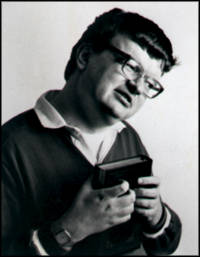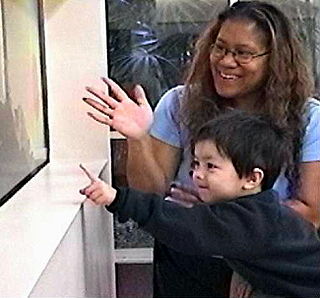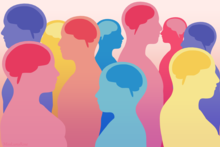
Asperger syndrome (AS), also known as Asperger's syndrome, formerly described a neurodevelopmental disorder characterized by significant difficulties in social interaction and nonverbal communication, along with restricted and repetitive patterns of behavior, interests, and activities. The syndrome has been merged with other disorders into autism spectrum disorder (ASD) and is no longer considered a stand-alone diagnosis. It was considered milder than other diagnoses that were merged into ASD due to relatively unimpaired spoken language and intelligence.

Savant syndrome is a phenomenon where someone demonstrates exceptional aptitude in one domain, such as art or mathematics, despite significant social or intellectual impairment.

Art therapy is a distinct discipline that incorporates creative methods of expression through visual art media. Art therapy, as a creative arts therapy profession, originated in the fields of art and psychotherapy and may vary in definition. Art therapy encourages creative expression through painting, drawing, or modelling. It may work by providing a person with a safe space to express their feelings and allow them to feel more in control over their life.
High-functioning autism (HFA) was historically an autism classification where a person exhibits no intellectual disability, but may experience difficulty in communication, emotion recognition, expression, and social interaction.
A hug machine, also known as a hug box, a squeeze machine, or a squeeze box, is a therapeutic device designed to calm hypersensitive persons, usually individuals with autism spectrum disorders. The device was invented by Temple Grandin to administer deep-touch pressure, a type of physical stimulation often self-administered by autistic individuals as a means of self-soothing.
The following outline is provided as an overview of and topical guide to autism:

The University of North Carolina TEACCH Autism Program creates and disseminates community-based services, training programs, and research for individuals of all ages and skill levels with autism spectrum disorder (ASD), to enhance the quality of life for them and their families across the lifespan.

Autism therapies include a wide variety of therapies that help people with autism, or their families. Such methods of therapy seek to aid autistic people in dealing with difficulties and increase their functional independence.

Self-stimulatory behavior, also known as "stimming" and self-stimulation, is the repetition of physical movements, sounds, words, moving objects, or other behaviors. Such behaviors are found to some degree in all people, especially those with developmental disabilities such as ADHD, as well as autistic people. People diagnosed with sensory processing disorder are also known to potentially exhibit stimming behaviors.
Sensory integration therapy (SIT) was originally developed by occupational therapist A. Jean Ayres in the 1970s to help children with sensory-processing difficulties. It was specifically designed to treat Sensory Processing Disorder. Sensory Integration Therapy is based on A. Jean Ayres's Sensory Integration Theory, which proposes that sensory-processing is linked to emotional regulation, learning, behavior, and participation in daily life. Sensory integration is the process of organizing sensations from the body and from environmental stimuli.

Societal and cultural aspects of autism or sociology of autism come into play with recognition of autism, approaches to its support services and therapies, and how autism affects the definition of personhood. The autistic community is divided primarily into two camps; the autism rights movement and the Pathology paradigm. The pathology paradigm advocates for supporting research into therapies, treatments, and/or a cure to help minimize or remove autistic traits, seeing treatment as vital to help individuals with autism, while the neurodiversity movement believes autism should be seen as a different way of being and advocates against a cure and interventions that focus on normalization, seeing it as trying to exterminate autistic people and their individuality. Both are controversial in autism communities and advocacy which has led to significant infighting between these two camps. While the dominant paradigm is the pathology paradigm and is followed largely by autism research and scientific communities, the neurodiversity movement is highly popular among most autistic people, within autism advocacy, autism rights organizations, and related neurodiversity approaches have been rapidly growing and applied in the autism research field in the last few years.

Classic autism, also known as childhood autism, autistic disorder, (early) infantile autism, infantile psychosis, Kanner's autism,Kanner's syndrome, or (formerly) just autism, is a neurodevelopmental condition first described by Leo Kanner in 1943. It is characterized by atypical and impaired development in social interaction and communication as well as restricted, repetitive behaviors, activities, and interests. These symptoms first appear in early childhood and persist throughout life.
Asociality refers to the lack of motivation to engage in social interaction, or a preference for solitary activities. Asociality may be associated with avolition, but it can, moreover, be a manifestation of limited opportunities for social relationships. Developmental psychologists use the synonyms nonsocial, unsocial, and social uninterest. Asociality is distinct from, but not mutually exclusive to, anti-social behavior. A degree of asociality is routinely observed in introverts, while extreme asociality is observed in people with a variety of clinical conditions.

Autism, formally called autism spectrum disorder (ASD) or autism spectrum condition (ASC), is a neurodevelopmental disorder marked by deficits in reciprocal social communication and the presence of restricted and repetitive patterns of behavior. Other common signs include difficulties with social interaction, verbal and nonverbal communication, along with perseverative interests, stereotypic body movements, rigid routines, and hyper- or hyporeactivity to sensory input. Autism is clinically regarded as a spectrum disorder, meaning that it can manifest very differently in each person. For example, some are nonspeaking, while others have proficient spoken language. Because of this, there is wide variation in the support needs of people across the autism spectrum.
A sensory room is a special room designed to develop a person's sense, usually through special lighting, music, and objects. It can be used as a therapy for children with limited communication skills.
Autism-friendly means being aware of social engagement and environmental factors affecting people on the autism spectrum, with modifications to communication methods and physical space to better suit individual's unique and special needs.
This relationship between autism and memory, specifically memory functions in relation to Autism Spectrum Disorder (ASD), has been an ongoing topic of research. ASD is a neurodevelopmental disorder characterised by social communication and interaction impairments, along with restricted and repetitive patterns of behavior. In this article, the word autism is used to refer to the whole range of conditions on the autism spectrum, which are not uncommon.

A weighted blanket is an especially heavy blanket that is used to aid sleep and reduce anxiety. Initially, weighted blankets were most commonly used as therapeutic tools to assist individuals with autism spectrum disorders (ASD), dementia, and mental health conditions. They have subsequently become a mass-market product. Scientific evidence does not support their use as an aid for insomnia, and they can be dangerous, particularly for children.
Ping Lian Yeak is a Malaysian Australian artist based in Sydney. He is described as having reached a significant artistic achievement. He was diagnosed with autism at a young age.

Equine-assisted therapy or equine-assisted therapy on autistic people is a therapy using a mediating horse or pony. A session can take place on foot or on horseback. Equine-assisted therapy is one of the few animal-assisted therapies regularly studied for its effectiveness, and the most popular of all autism therapies.












